The practice of khatna on girls must stop / છોકરીઓ પર ખત્નાની પ્રથા બંધ થવી જોઈએ

By Hakim Rangwala Even in today’s modern age, when Mukesh Ambani entrusted his daughter Isha with the management of a multi-crore retail business, there exists a very repulsive and harmful practice among the Dawoodi Bohra, a Shia sub-sect that generally looks modern and reformist on the surface. When a girl is young, the Bohras cut her clitoris. They believe this to be a religious rite, and even today, well-educated Bohras and those with big businesses strictly practice it. Among Bohras all over the world, this practice of khatna is done by women themselves, and in cities and towns where there is no such woman, girls are taken abroad for it. This organ given by nature [the clitoris], which gives women the maximum sexual pleasure, is called ‘bhrugankur’ in Gujarati. Taking it away from a woman is a harm like no other. This is the only one. A few years ago, a case was filed against three Bohras in Australia for carrying out this practice of khatna on two young girls. This practice is illegal in Australia and other Western countries. Because of this case, the Bohra jamaats in Sydney and other such Western cities issued notices to the local communities not to perform khatna on girls. Now, some humanitarians have filed a legal appeal in court to demand that this practice is banned in India. I think it is not too much to expect that the good people reading this should also join in making this demand to abolish this harmful practice. Hakim’s blog post was originally written in Gujarati. Here is the untranslated version: મુકેશ અંબાણીએ દીકરી ઈશાને લાખો-કરોડો રૂપિયાના વહીવટનો રિટેઇલ વેપાર સોંપીને સ્ત્રી પ્રત્યે સન્માન અને વિશ્વાસ દાખવ્યો એવા આજના આધુનિક યુગમાં પણ ઈસ્લામના શિયા સંપ્રદાયનો પેટા સંપ્રદાય દાઉદી વ્હોરા, જે સામાન્ય રીતે ઉપરથી આધુનિક અને સુધારાવાદી દેખાય છે, એ વ્હોરાઓમાં એક અતિ ધૃણાજનક અને ક્રૂર પ્રક્રિયા અસ્તિત્વમાં છે. સ્ત્રી જ્યારે નાની બાળકી હોય છે ત્યારે આ વ્હોરાઓ એ બાળકીના ક્લાઈટોરીસ નું છેદન કરાવે છે. આ ક્રિયાને તેઓ ધાર્મિકતા સમજે છે અને મોટા કહેવાતા ઉદ્યોગપતિઓ, ભણેલા- ગણેલા દાઉદી વ્હોરાઓ પણ આ ક્રિયાનું ચુસ્ત પાલન કરે છે આજના યુગમાં પણ. દુનિયા આખીમાં સ્ત્રી ખતના કરવાનું કામ ખુદ વ્હોરા સ્ત્રીઓ જ કરતી હોય છે અને જ્યા એવી સ્ત્રી ન રહેતી હોય એ ગામ-શહેરના લોકો પોતાની બાળકીઓને બહારગામ લઈ જઈને પણ આ ખતના કરાવે છે. સ્ત્રીને સેક્સમાં મહત્તમ આનંદ આપતું કુદરતે એને આપેલું અંગ જેને ગુજરાતીમાં ભૃગાંકુર કહે છે. આ અંગ સ્ત્રી પાસેથી આંચકી લેવું એના જેવી ક્રૂર ક્રિયા બીજી એકેય નથી. આ એક અને અજોડ ક્રૂરતા છે. અમુક વર્ષો પહેલા ઓસ્ટ્રેલિયામાં બે યુવતીઓ પર ખત્ના કરવા બદલ ત્રણ વ્હોરા સામે કેસ દાખલ કરવામાં આવ્યો હતો. ઓસ્ટ્રેલિયા અને પશ્ચિમના અન્ય ઘણા દેશોમાં છોકરીઓ પર ખટના ગેરકાયદેસર છે. આ કેસને કારણે, સિડનીમાં અને આમાંના ઘણા પશ્ચિમી શહેરોમાં વ્હોરા જમાતે સ્થાનિક સમુદાયને હવે છોકરીઓ પર ખત્ના ન કરવા સૂચના આપી છે. હવે ભારતમાં આવી ક્રૂર પ્રથા ન હોવી જોઈએ કાયદાથી એવી માંગ અમુક માનવતાવાદી લોકોએ ઉપાડીને કોર્ટમાં અપીલ કરી છે. આ વાંચનાર ભલા લોકોએ પણ આ માંગ માં જોડાવું જોઈએ અને આ ક્રૂર પ્રથા નાબૂદ થવી જોઈએ એવી અપેક્ષા વધુ પડતી નથી જ એવું મને લાગે છે, હો સાહેબ….. In honor of Father’s Day 2024, Sahiyo’s male engagement program, Bhaiyo, has launched a month-long public awareness campaign to uplift the importance of male voices and allies in ending FGC. If you would like to contribute, please email sheena@sahiyo.org. Related: Breaking the Silence: A Conversation with My Father About FGM/C How to have effective conversations about FGC Why men too must speak out against Khatna
Do I belong? Reflecting on the Activists Retreat
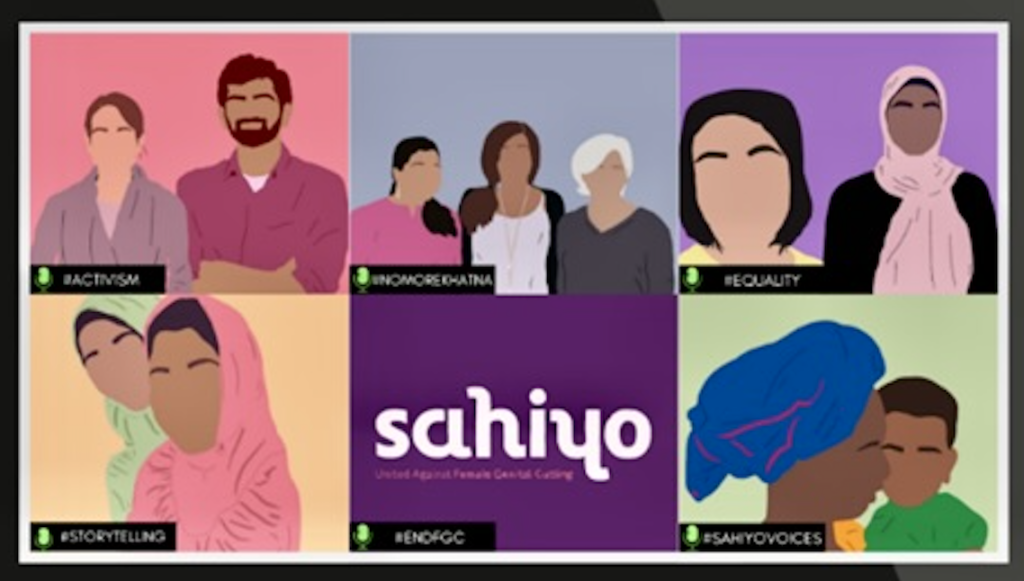
By Sakina Sharp Sahiyo’s annual Activists Retreat is a great way for both women and men connected to the Bohra community to discuss the issue of khatna, or female genital cutting (FGC). This is my third year attending the event, and I appreciate that this Retreat offers a safe space to have conversations about khatna. The first year I attended the event, I wondered if I belonged; I did not know if there was a space for someone like me who grew up Bohra, but does not currently fulfill all the requirements of the culture. I also wondered if there was a space for those Bohras who do “all the things,” and stand up against the practice of khatna. When I attended the Retreat, I realized that there was space for both. I found the Retreat to be cathartic, and it gave me an opportunity to process what had happened to me as a child. During this recent Retreat, the question of belonging came up again, but this time with a different flavor. Some participants wondered if they belonged because they had not personally undergone FGC. We all wonder if we belong, and the truth is, we all do. Men belong because we need their voices in the rooms where discussions on FGC are taking place. Women who have not undergone FGC belong because they can prevent future generations from holding on to this practice. Practicing Bohras belong because FGC is not a religious practice; we can be religious and still stand against khatna. Survivors belong because we know first hand the impact of khatna. All of our voices are important, and we all belong. Learn more about Sahiyo’s Activists Retreat here.
End FGM – Save our daughters
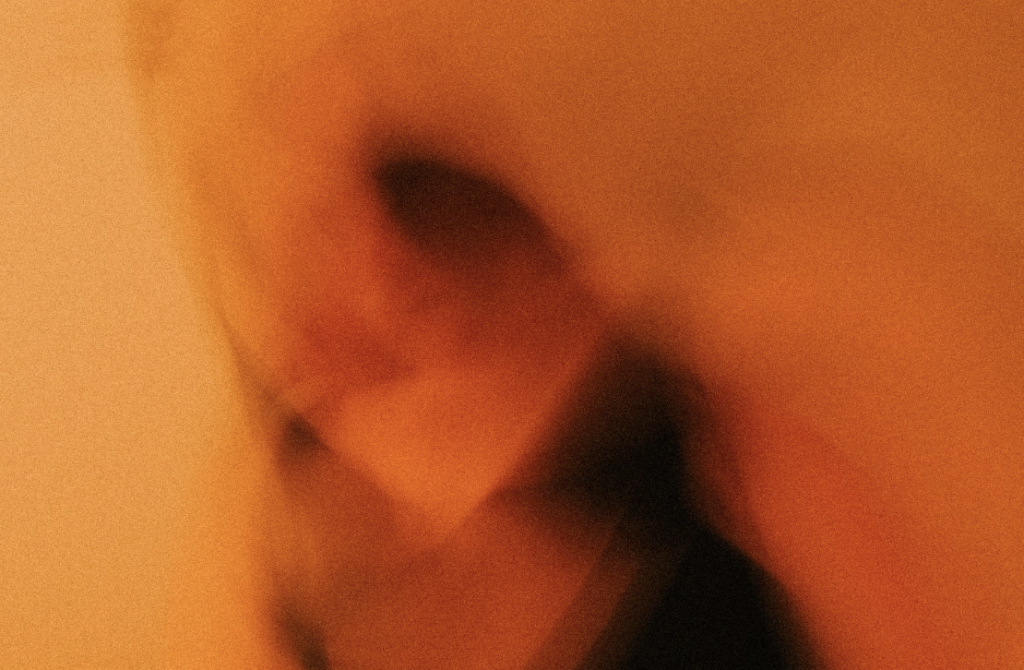
By: Arwa Country of Residence: India Today, I’m referring the most underrated topic ‘khatna’ or Female Genital Mutilation (FGM/C). I call it underrated because it doesn’t seem like educated persons in my society are talking about it even a little bit. It’s also called ‘Khafz’ in Islamic terms, and it’s a ritual in the Dawoodi Bohra community. Khatna usually takes place at the age of seven with girls. In the process of khatna, they cut the tip of the female sexual part ‘clitoris’ from the female genitalia with the use of a crude blade without giving any precautions. The purpose of doing that is to curb sexual desires. In some countries, it’s illegal, but India has no laws against khatna or FGM/C. The World Health Organization (WHO) considers it harmful for girls in many ways and has no health benefits. It includes damaging healthy tissues in females and causes trouble with the natural function of girls’ bodies. Many survivors have experienced pain, lifelong physical and psychological trauma. Some immediate complications include: Severe pain; Excessive bleeding; Vaginal infections; Wound healing problems; Shock; And in some cases death. Firstly, let me make this clear, I’m not against any religion but also do not support any religion in that way. What I mean is, I’m not against any religion but also I don’t have blind faith in it. I think there’s a major difference between beliefs and faith that our society needs to understand. I believe: If you do good, you will get good. I have read many articles on FGM/C. Community guidelines say ‘khafz take place for maintaining the taharat (pureness) and for spiritual purity.’ After reading it I felt like I would burn from inside, what has the world come down to. My heart was broken. Cutting out a human body part for spiritual purity; why would god give you something which makes you spiritually impure and then ask you to cut it off to become spiritually pure? I really don’t understand the logic behind FGM/C. What is the point of education that you are talking about? We are nurturing ourselves with modern education, reading about all atrocities going on in the world, when the same thing happens in our society; we are blind folded letting this happen. Many people have said that khatna is a good thing to do. It decreases sexual desires. So to that I ask, how do you know that a girl at age seven has sexual desires? Some had written in an article that it keeps the girl decent so girls won’t enter into adultery later, so on that I’m asking, where is the evidence of that? If we want our daughters to be pure, let’s teach them that they are strong and powerful women. They are in control of their own minds and bodies and they can use them wisely. When she was born, you promised to protect her. At the age of seven, they trust their family and parents the most. Parents tell them not to interact with strangers or not to let anyone touch you in your private areas, still it’s the family who takes them for khatna and allows strangers to touch and cut their girl’s clitoris. Why do something terrible to your girl which can leave scars on a mental level? People have to change their minds about old rules and regulations which they follow in the name of ‘tradition’. Families have a big role in ending FGM/C or khafz. Protect our girls. Our girls matter! I want to say a few things. I’m talking about this not for the sake of talking but for contributing to the voice that the Islamic religion (Bohra) seems to be avoiding. They have been avoiding it for years, but you can make sure they don’t avoid contributing by talking about this. Social media, I honestly believe, is one of the most powerful platforms. Otherwise also suppose- You are a teacher – you can probably discuss with your institution at the next assembly you can talk to your students about this. If you are in company you can hold a meeting in your office and talk about child abuse. Talk about this issue a little bit and tell people they need to speak up too. Maybe you can organise an activity or webinar regarding this issue. Whatever is in your capacity or power, do it please. It’s a harmful and outdated practice that needs to stop. Use your voice. It will definitely take time to go away but it doesn’t mean we keep sitting quietly. They are survivors, not victims. I’m a modern feminist and Bohra girl. I’m not a victim, I’m a survivor. I almost sat quietly, i didn’t talk about it but then I realised I must and so must you. Time to step forward for our daughters. Protest, speak up, fight for your daughters and let’s hope that the world changes for the better.
मैंने अपनी मां से मेरा खतना नहीं करने की विनती की। उन्होंने मेरी बात सुनी
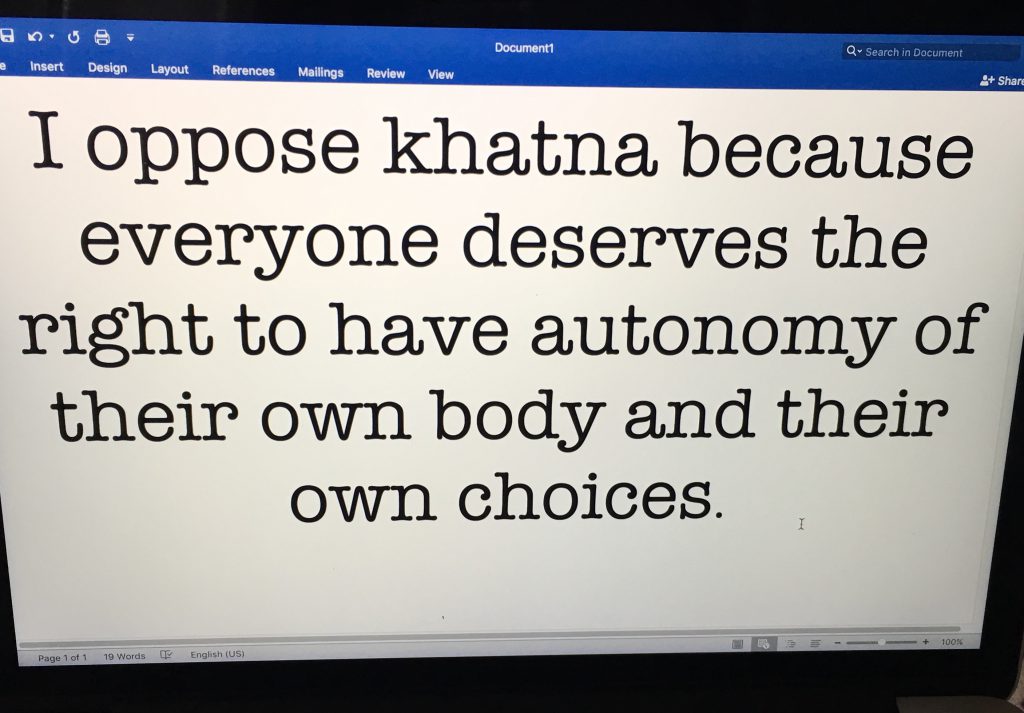
(This article was originally published in English on November 8, 2016. Read the English version here.) नाम: अज्ञात उम्र: 26 देश: संयुक्त राज्य अमेरिका शनिवार की स्कूल की क्लास में मैंने पहली बार इसके बारे में सुना। एक पुरुष शिक्षक उस शनिवार की सुबह हमारी क्लास में पढ़ा रहे ते, और विषय था खतना। उस 14 वर्ष की उम्र में, मुझे वास्तव में पता नहीं था कि इसका मतलब क्या है, लेकिन मुझे पता था कि इसमें कुछ ऐसा शामिल था जो यौन-शिक्षा से संबंधित था। मैं शर्मिंदगी भरी स्थिति में कमरे के दाईं ओर लड़कियों के साथ बैठी थी, और लड़के कमरे के बाईं ओर बैठे थे। शिक्षक ने पुरूष खतना के बारे में बोलना शुरू किया; कहा कि उसमें त्वचा को सर्जरी के द्वारा हटा दिया जाता है, स्वच्छता के लिए। उसके बाद उन्होंने महिला खतना के बारे में बताया; कि यह एक लड़की की यौन इच्छा पर अंकुश लगाने के लिए किया जाता था। लड़कियों को पवित्र, शांत और आज्ञाकारी बनाना था। छोटी लड़कियों का खतना करना उन्हें असंयमित होने से बचाने का एकमात्र तरीका था। यह उनके परिवारों को शर्मिंदा होने से रोकने का एकमात्र तरीका था। मुझे याद है कि वहां बैठकर मुझे पता नहीं था कि मेरे शिक्षक किस बारे में बात कर रहे हैं। मुझे यकीन था कि मैं कभी भी इस प्रक्रिया से नहीं गुज़री थी। मैं उस दिन उस कमरे में बैठी हुई बहुत असहज और अशांत महसूस कर रही थी। मुझे याद है कि उसी शनिवार को हम सहेलियां क्लास की एक बड़ी लड़की के घर रहने गए थे, जहाँ पर उस दिन क्लास में जो सुना था उस विषय पर बात होने लगी। मैं चुपचाप बैठी रही जब एक दूसरी लड़की ने समझाया कि यह प्रक्रिया लड़कियों पर क्यों की जाती है, कैसे यह हमें बेहतर मुसलमान और बेहतर बोहरा बनती है, क्योंकि खतना यह सुनिश्चित करता है कि हम में यौन इच्छाओं और विवाह पूर्व संभोग की चाह नहीं जगेगी। खतना ने हमें पवित्र किया था, हमें शुद्ध किया था। मैंने गौर से सुना जब अन्य लड़कियों ने अपनी खतना की कहानियों बताई। मुझे धोखा महसूस हो रहा था क्योंकि मुझे पता था कि मैं कभी भी इस “ज़रूरी प्रथा” से नहीं गुजरी थी। उस वक़्त मुझे इस ‘ज़रूरी प्रथा’ का सही मतलब नहीं पता था। मेरी समझ में सिर्फ यह आ रहा था कि मै उन लड़कियों के जैसी नहीं थी, कि मैं एक “बुरी लड़की” थी, कि मैं गंदी थी, और मैं सिर्फ एक अच्छी मुस्लिम होने का नाटक कर रही थी। मुझे याद है कि आखिरकार कुछ हफ्तों बाद मैंने अपनी माँ से इसके बारे में पूछने की हिम्मत जुटाई। उम्मीद भरी आवाज़ से मैंने उनको पूछा कि क्या मेरे साथ यह हुआ था, और बस मुझे याद नहीं था? उनका चेहरा बदल गया । उन्होंने अपना सिर हिलाया। जब हम भारत में थे तब उनको हमेशा मेरे मेरा खतना करवाना था, लेकिन कभी मौका नहीं मिला। मैंने उनको अपने दोस्तों से सुनी हुई कहानियाँ सुनाईं और उनसे पूछा, क्या वह मुझे इस प्रक्रिया को समझा सकती हैं, क्योंकि मुझे अपनी क्लास में इसे समझने में परेशानी हुई थी। उन्होंने मुझे खतना की प्रक्रिया समझाना शुरू किया; कैसे एक लड़की के भगशेफ या क्लाइटोरिस से त्वचा को हटाया जाता है, उसे पवित्र और शुद्ध बनाने के लिए। जैसे ही मैंने पूरी बात सुनी, मैं डरकर पीछे हट गई। उन्होंने मुझे कुछ मिनटों तक देखा, और फिर अधिकार के साथ कहा कि अगली बार जब हम भारत जाएंगे, तो वह मुझे मेरी चाची, जो एक डॉक्टर हैं, उनके पास ले जाएँगी जो मुझ पर खतना करवाएंगी। मैं उनके सामने अपने घुटनों के बल बैठ गई, उनसे भीख माँगते हुए कि मेरे साथ यह न करें, भीख माँगते हुए कि इस अकल्पनीय दर्दनाक प्रक्रिया से ना गुजरने दें। मैंने उनसे वादा किया कि मैं अच्छी रहूँगी, मैं स्वच्छ रहूँगी, मैं वह कुछ भी करूँगी जो वह चाहती थी अगर वह इस पूरी बात को भूल जाएँगी। उनहोंने सिर्फ इतना कहा कि “हम देखेंगे।” मुझे याद है बड़े होते हुए, मैं खतना के बारे में और अधिक शोध करती रही यह जानने के लिए कि आख़िर यह होता क्या है। एक बार मेरे चचेरे भाई ने बड़े जोश से बताया कि यह कितना गलत है। तब मुझे एहसास हुआ कि मेरी माँ ने मुझे कितने बड़े नुकसान से बचाया है। आज मैं खतना को बहुत अलग नज़र से देखती हूँ। कई युवा लड़कियों से उनका चुनने का अधिकार छीन लिया गया है। किसी ने उनसे नहीं पूछा कि क्या वे खतना कराना चाहते हैं। उनके परिवारों ने उनके अस्तित्व के एक हिस्से को चुराने का फ़ैसला कर लिया, इस बारे में कोई परवाह किए बिना कि इसका उन पर क्या असर होगा, और अक्सर अपनी अनमोल छोटी बच्चियों को अस्वच्छ और अनुभवहीन हाथों में देने का निर्णय लिया। मुझे याद है कि महीनों पहले एक बड़ी फेसबुक चर्चा खुलकर बाहर आई, जिसमें मेरे पहचान की एक बहुत ही मुखर लड़की ने खतना के खिलाफ आंदोलन करने वालों पर पर आरोप लगाया कि वे बोहरा समुदाय की “गंदगी” को पब्लिक में बाहर ला रहे थे। उस पल के पहले मैंने अपने समुदाय के किसी व्यक्ति पर इतनी शर्म महसूस नहीं की थी। यह प्रथा गलत है, और इसका गैर-रजामंदी वाला स्वरूप मेरे लिए इसे और भी दिल दहलाने वाला और निंदनीय बनाता है। जब आपका समुदाय कुछ ग़लत कर रहा है, और इसे पैगंबर (अल्लाह उनको शांति दे) द्वारा सिखाई गई एक धार्मिक प्रथा के रूप में बता रहा है, तब आप इससे छिपकर भाग नहीं सकते हैं। आपको बहस करने के लिए मुँह खोलना पड़ेगा और चर्चा करना होगा कि हम एक समुदाय के रूप में बेहतर कैसे बन सकते हैं। आपको चर्चा करना होगा कि हम अपने समुदाय की युवा लड़कियों और युवा महिलाओं की सुरक्षा कैसे कर सकते हैं। एक वैश्विक समुदाय होने के नाते हम इसे रोकने के लिए बहुत कुछ कर सकते हैं। मेरी मां ने मुझे बचाया था। उन्होंने मेरे लिए अपने प्यार को सबसे पहले रखा, और आज उनकी वजह से मैं एक पूर्ण महिला हूँ। मैं उनकी सुरक्षा और मार्गदर्शन के
Announcement: A new research project on Khatna in Mumbai

by Keire Murphy and Cleo Egli An exciting new research project is being undertaken in Mumbai and its environs this summer which hopes to bring a new perspective to the international discussion of khatna. The project, which is a cultural study on khatna, the Bohra community, and the current activist movement against the practice, is being carried out by Keire Murphy from Trinity College Dublin and Cleo Egli from the University of North Carolina, who has been awarded the Mahatma Gandhi Fellowship in order to complete the project. It will be interesting to see how an entirely external perspective engages with the Bohra culture and cultural specificities of khatna, which is so distinct from the practice portrayed in Western media. The stated goal of the project is to explore and understand not just the practice but also the culture (or cultures) of the Bohra community. The researchers hope that this will enable them to make recommendations to activists coming from outside of the community hoping to work on this issue on how to engage with this issue in a culturally sensitive and culturally specific way. Murphy and Egli claim to have undertaken this project because of the lack of research that has been engaged in not only on the subject of khatna but also on the Bohra community itself, which they believe is an essential step to effecting lasting social and cultural change. For them, “In order to change, we must first understand”. The women want to explore the identities of the members, particularly the female members, who comprise the Dawoodi Bohra community, how the community defines itself, the tensions and divisions within the community as well as its unifying factors. They want to explore the “beauty and pride of the community in order to better understand its controversial underside.” They are particularly interested in exploring the current movement within the community, led by SAHIYO and Bohra women; how the movement is perceived by the people it is aimed at and what factors are integral for a woman deciding whether to continue the long-standing tradition or face the possible repercussions of breaking with the ancient mold; and what distinguishes a woman who simply doesn’t continue the practice from a woman who goes further and actively campaigns against it. This project will hopefully be a significant stepping stone to bringing global humanitarian and academic attention to this issue that has often been overshadowed by African practices that, although put in the same category globally, so little resemble the experience of the Dawoodi Bohra. This project is also hoping to act as a precursor and guide for the more comprehensive studies that this issue deserves. This is an incredibly important time for the Bohra community both within India and Pakistan and abroad, with media attention being dramatically drawn to the issue by the highly publicised arrests of practitioners of khatna in the United States. The community may be facing a large amount of media attention in the coming years and it is the aim of this project to provide the members of the community with an opportunity to set the story straight from the beginning about who they are. The study will take place in Mumbai from June 24 to July 23, 2017, and researchers are calling for research participants, both in Mumbai on these dates or in other parts of India from July 24 to August 7. They also have an open call without date restrictions for participants who would like to engage in interviews over Skype. Participants can be male or female and do not have to speak of their experience of khatna if they would prefer not to. All Bohras are encouraged to participate so that the research will be representative of all groups and opinions in the community. Submissions are also welcome, but interviews will be given more weight. All interested parties should contact mgfmumbai@gmail.com. A part-time translator job opportunity is also available. To view job description, click here.
We must find culturally sensitive methods to end FGC and protect girls from further trauma
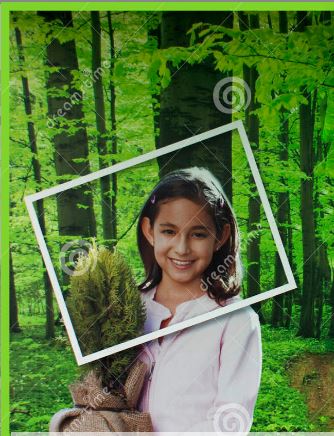
Picture an innocent, 7-year-old girl being led to an unfamiliar room. She is made to lie down, her underpants are removed, and a piece of her is cut away; familiar hands around her upholding an age-old tradition. Perhaps she is in pain. Perhaps she is not. She might feel betrayed, scared, angry, or upset. She might want to run away from the people who are albeit familiar to her, but who have put her in an extremely traumatic situation. Now picture this same girl once again, made to lie in a an equally unfamiliar room, her underpants removed, her private parts probed by a doctor, who is looking for the scar from the piece that was cut away from her; these concerned hands are trying to build a case to condemn the ones who caused her the original pain. The girl is once again in pain, but this time it may not be just a physical pain. She is again angry, scared, and confused. And this time, she probably wants to run back to those who are familiar to her, to save her from the trauma of reliving that memory. The above two scenarios sadly highlight the unfortunate situation that innocent Bohra girls in the US are reportedly in. The girls are possibly feeling trapped, fearful, and vulnerable, because once again they are being forced to relive their trauma of undergoing Khatna. Recently, Female Genital Cutting or Khatna prevalent in the Dawoodi Bohra community came onto the federal radar in the US because of the arrest of a doctor associated with the practice in Detroit, Michigan. This arrest was followed by a few more arrests leading to subsequent intervention by Michigan’s Child Protection Services who reportedly picked up children for further questioning. While we need law to make clear that FGC is a human rights violation, and we need legal aid to further efforts towards preventing FGC from occurring in the first place, subjecting a child to a double scrutiny of sorts may not be the best practice if we keep the interests of the child in mind. For instance, one has to understand that Bohra-style Khatna can be difficult to establish in a medical examination, because Type 1 or Type 4 (which Bohras typically perform) do not necessarily leave physical scars. The girl may have lost a thin layer of her prepuce, or she may have been pricked, slit or rubbed, in which case subjecting them to medical check-ups is not going to prove anything, and may, in fact, cause them trauma when previously they may not have been particularly traumatized. Additionally, carrying out a witch hunt on all the mothers, possibly separating the girls from their parents, and asking for a ‘permanent termination’ of rights to parenting, are all methods that might force the Dawoodi Bohra community into believing that they are being targeted unfairly, and these actions might make them distrustful of law enforcement officials. Moreover, the child might view the authorities trying to protect her as her worst enemy, because they separated her from her parents and everything that is comfortable and familiar to her. She might also feel pangs of guilt if her testimony leads to her mother’s arrest. After all, no child wants to be the reason for a family’s disruption. There is no doubt that the US government is doing exceptionally well in investigating the case, and ensuring that the laws of their land are rightfully upheld. Nevertheless, Sahiyo does feel that there are certain realities, which if understood and implemented correctly, could make the process of serving justice less painful for the child. For instance, what could be explored is how to gain insight around culturally appropriate and sensitive forms of outreach from the people and agencies who are knowledgeable in working with the community. Since its inception, Sahiyo’s philosophy has been to engage the members of the community and seek their help to end this harmful practice. So we ask now, could an alternate approach be found that acknowledges Khatna as a harmful tradition that must be discontinued, but simultaneously recognizes that parents’ intentions for continuing it are not necessarily malicious? Or, could there be a more educative, community-involved approach to tackling FGC which recognizes it as a social norm that unfortunately has been passed down through generations of a community? Could state-organized counseling sessions for the parents and children be an alternative to punitive punishments? We ask these questions because we acknowledge that to truly end FGC in the Dawoodi Bohra community, we must find methods that will not cause further trauma for the child, but at the same time, continue to move the community forward towards abandoning this undesirable and harmful practice.
Memories of a cry: A Bohra woman’s poem on her Khatna
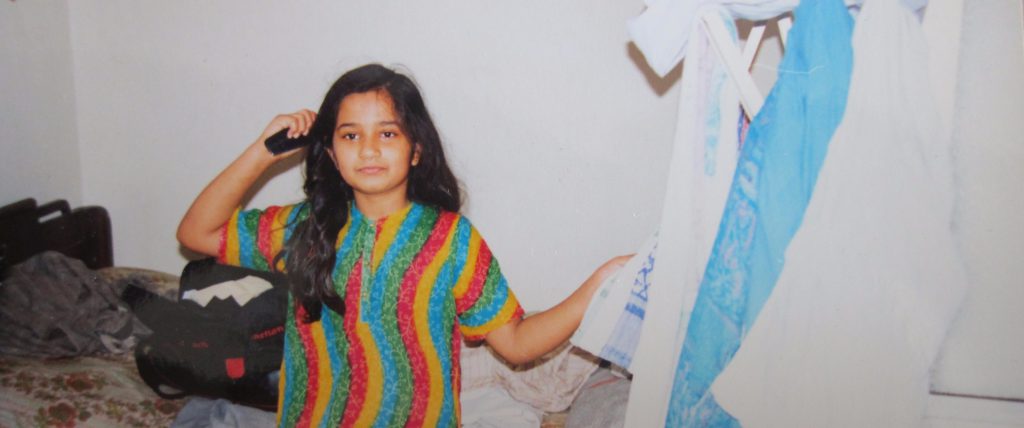
by Sunera SadicaliCountry: Portugal / Spain Memories of a cry When I was eightwas too young to complaintoo old to forget. Went on a family tripKarachi was warm, humid, overwhelming, tasty, spicy.Had long hair and soft brown skin.Went to MadrassaLearnt to recite some verses by memory.Laughed out loud, met new friends. It was hard, sometimes…the crowd, the men just staring on the streetsall the compulsories. One daywent to a certain doctor, a woman.I was eight and healthyMy sister, my cousin, and meremember an old building, the peculiar smell…A sliding door.I loved the street food, the pani puri, the colourful shalwar kameez.We waited in the hall, wooden chairs. My cousin was first,after some time, don’t remember how muchheard a scream, sharp sound of pain…my cousin’s cry. I was nextI was afraid, hesitating, felt insecureMy mother and my khala were there with me.There was a small room,It was hotI was sweating.A weak-lit room, yellowish, humid.I was put on a gurney– then everything just went very fast, in my memories…They told me that I had a “worm” between my legs that must be cut,slicedMy mother and my aunty grabbed my legs stronglyI remember freshly the painsharp and bloody-pain.I felt shame and did not realize what happened. Then, my sister’s turnand again the cry…I still feel a knot in the stomach.Not for the pain, rather the yell. I was thirteen when I realizedthat “the worm”, was a bit of my flesh,The sinful bit-of-clitand yet I was not guilty at eight,nor my mother at 28. We are not good enoughif we do not bowif we do not obeyif we do not have it cut properlyif we are not modest.If we speak too muchif we enjoy too muchif we question too much.
A letter on khatna by a young Bohra man
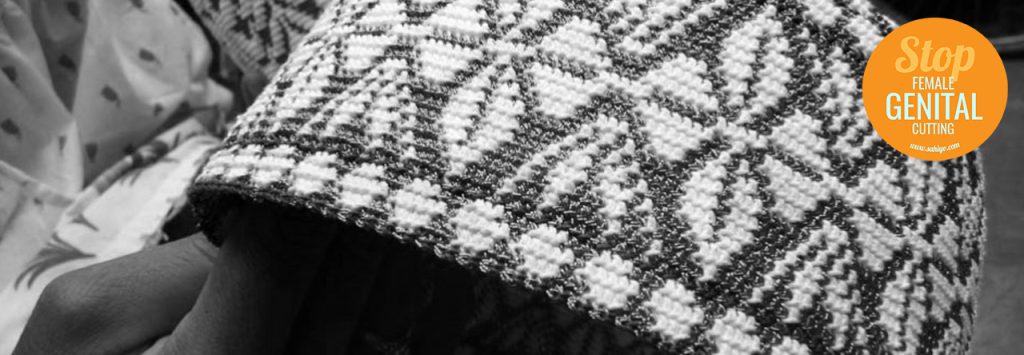
by Anonymous Age: 28 Country: United States Hello All, Firstly, I would like to start by telling you how ashamed I feel of being so ignorant about the issue of female khatna and how honored I am to be a part of a family whose women are spearheading the fight against FGM. I am from an Islamic Dawoodi Bohra family that comprises mainly of women. I have six beautiful sisters. They have all undergone khafd (khatna). Back then, there was no awareness and there was tons of social pressure. Everything was done quietly and no one spoke about it. At least in my community, it was a given that a girl child had to have her khatna done. Not doing it would be condemned. Women who have gone through FGM have started talking about their experiences. Openly speaking about this issue has done great good for the community as it has helped build awareness and made folks like me, who were ignorant about it, read and learn more about it. I salute the women who have been bold to talk about this. Thank you! Listening to these experiences makes me really sad. Sad because this has been going on for so long and this practice has absolutely no foundation. It makes me sad that educated people never questioned it and were so socially engrossed that they just did what they were told to do. It makes me sad because it just proves how sexist the world is (which I do not want to believe). It saddens me because parents are still putting their daughter through this. For my religious friends: the Quran does not even mention khatna. So please do not put a religious aspect to this practice. This practice only has side effects. For those who are not aware – please please read here. More importantly – it is her body, please respect it. This issue is important and it must be dealt with. It needs support from each and every member of the community including the men.
I am grateful I was able to talk to a therapist about my khatna

(First published on January 6, 2016) by Anonymous Age: 30 Country: United States I was not more than seven years old when I recall going into a medical complex on a quiet Sunday afternoon accompanied by my mother and our family friend. My mother told me it was time for my “khatna” or circumcision. She explained it as a rite of passage, something all the little girls in our Dawoodi Bohra community had to do. I remember feeling scared but I didn’t know exactly why. I just had a feeling something terrible was about to happen to me as our friend unlocked the building with her keys and we continued into her desolate practice. We went into one of the brightly colored rooms where alphabet wallpaper boarded me in. I started crying before it even happened while she crooned, “all I’m going to do is remove a liiiitle piece of skin.” Totally exposed, I was asked to relax and read the wallpapered alphabet backward. My mother helped hold me still while I was flat on my back and in hysterics. The snip which took maybe half a second was followed by a sharp-shooting pain that seemed to last in that moment, for eternity. I bled for three days and then it was over. It wasn’t until I was nineteen, the end of my freshman year in college that I stumbled upon an article from one of my classes, describing the experience of a woman who had been a victim of FGM, or female genital mutilation. After reading the article once, I was immediately reminded of that Sunday afternoon twelve years prior. There was no way the same thing could have been done to me. My seven-year-old perspective of a little piece of skin being removed was analogous to that of a piece of skin from the top layer of the palm of a hand. My cousin used to stick a needle through that top layer and tell me it was magic that the needle was sticking there. She eventually revealed her secret and showed me the protective top layer that separated her hand from the skin. I guess like that layer, I always figured it would grow back. Still, the feeling of uncertainty drove me to call a couple of peers and academics in my community to ask whether our “khatna” was in fact, a partial removal of my clitoris. Their answer confirmed the worst of my fears. My next concern of “how much?” tormented me, and after a frantic visit to the school nurse, I got my answer: “There’s only a remnant left,” said the nurse practitioner who examined me. *** I don’t believe my discovery was adequately addressed the first time as the rest of my college experience was consumed by bouts of grief, rage, frustration, insecurity, and depression. My feelings only grew stronger as I got older and had more encounters with the opposite sex. My overcompensating, defensive attitude permeated all aspects of my life—friends, family, work, and academics. It wasn’t until my mid-20s when I shared with my gynecologist during a routine visit what happened to me, that I was given three names of specialized therapists in the area with whom I could speak about my concerns. My insurance provider at the time would not cover therapy. Fortunately, one of three therapists agreed to see me for a discounted out-of-pocket fee because she was interested in my case. To this day, I am so grateful for the opportunity I had to talk through what happened to me in a safe space as such resources and treatment were unavailable to me at home or in my community. I learned it was ok to talk about sex, explore my sexuality, and sexual feelings. I was even prescribed homework to assist me in doing so. At the time of the therapy, I had been sexually active and my partner, who was incredibly supportive, was also invited to participate in one of my sessions. When growing up, I never thought I would have sex before marriage. The idea behind the circumcision was to curb any sexual appetite I might have. Ironically, once I learned this had happened, I wanted nothing more than to have sex to see what my capabilities were. While I was incredibly nervous and insecure about having sex, I was more open to losing my virginity in the context of a serious relationship, which is how it happened for me. One of my main insecurities about sex was that I felt like I was driving without the headlights on. Often times, I didn’t know where to go or how to guide my driver. I felt like a failure. To this day, I still have not experienced orgasm. While sex is enjoyable for me and I could describe what I can achieve as a “mini-climax”, I am bothered by the fact that I may never get to experience this wonderful part of life. While it’s no secret many women who have not been “circumcised” struggle with the same issues, a part of me will always wonder if that would have been true for me had this not happened. I will never know.
I was spared from khatna because my Dadi happened to pass away

by Anonymous Age: 34 Country: India I came to know about the practice when I was seven years old, but all I knew was that khatna means removing something from your body. My two elder sisters have undergone khatna, but I was not cut. The reason for this is that my dadi (grandmother) passed away before it was my turn to be cut. My parents had got my sisters’ khatna done because of pressure from my dadi – otherwise, they never wanted to perform khatna on any of their daughters. I was in the 7th standard when I first discussed khatna with my mother. After coming from school, I told my mother about a class we had had on sex education, menstruation, puberty and bodily changes. My mom brought up khatna during this talk. She told me it is done to reduce sexual pleasure. Innocently, I asked her, “Mummy, maru pan khatna thavanu chhe?” (Will khatna happen to me also?) She said no, and I was very happy then. One of my sisters has a daughter, but she has decided she will not have khatna performed on her. I do not support this practice either. Such a tradition that harms women’s sexuality and rights should be stopped.
